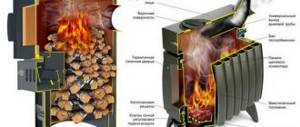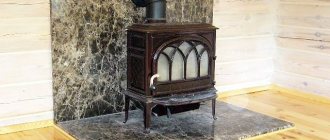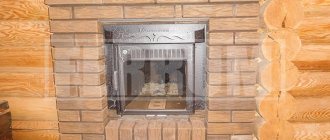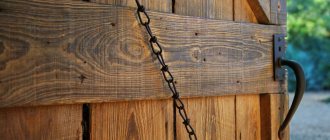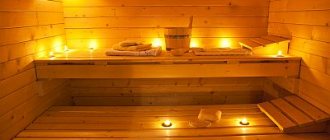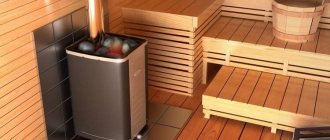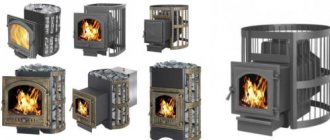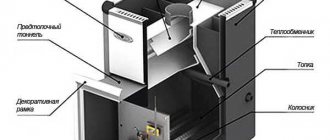Do you need protection in your bathhouse?
Protecting the walls of the bathhouse from the heat of the stove is not always required. For example, you can provide a distance between the wall and the stove, which will allow you to achieve fire safety without additional protection. The fact is that at some distance the IR rays emitted by the furnace begin to dissipate, which significantly reduces their impact on nearby surfaces.
The distance from the stove to the wall in the bathhouse varies depending on the type of stove:
- 0.32 m or more - the distance for a stone oven with quarter-brick masonry;
- 0.7 m or more is the required distance between the wall and the metal furnace lined with fireclay or brick from the inside;
- 1 m or more is a safe distance for an unlined metal furnace.
At first glance, it seems that creating such a distance is much easier than installing additional protection, but this is fundamentally wrong. Maintaining a safe distance is only advisable in large steam rooms, but in small private baths, the stove, including the indentations, will occupy most of the room, so it will be much easier to use insulation.
Wooden safety fence
You can prevent accidental touches to the stove by using a wooden fence for the stove. This type of protection is equally applicable in both the bathhouse and the sauna. It is important to observe fire safety measures and use suitable materials, for example, abashi wood, which is characterized by high moisture resistance and low thermal conductivity and heat capacity: its surface always feels warm to the touch, not hot. But this exotic wood is very expensive. Of our domestic species, alder and linden are perfect for these purposes. It is undesirable to use pine: it contains a large amount of resins, which, when heated, can cause burns.
Wooden fence for sauna stove
A wooden fence for a stove in a bathhouse or sauna can be purchased either ready-made or built with your own hands. We present you some options for installing it. If small children will visit the steam room, then create a fence in the form of a decorative fence, leaving very small distances between the boards so that even the smallest one cannot stick his hand in and get burned. If the steam room is visited exclusively by adults, you can make a barrier of a simpler design - several longitudinal and transverse guides, as in this photo.
Wooden fence for sauna stove
The distance from the stove to the wooden fence is usually indicated in the factory instructions for the stove. According to fire safety regulations, the distance from the stove to combustible materials must be at least 500 mm.
Wooden fence for sauna stove. This is if there are no children in the bathhouse
Important! Be careful when using wooden fencing. If darkening of color or other signs of heating appear, move the fence a little further.
Metal protective screens
On the construction market, the most common metal protective screens are made of steel or cast iron. Many manufacturers of iron furnaces provide thermal insulation for their products, providing them with special casings.
Choosing protective screens is quite simple, because depending on the side of the furnace to be insulated, you can purchase a front or side panel. Installing such screens will also not cause difficulties, because the manufacturer provides special legs that can be easily attached to the floor.
Next we should talk about the installation rules. The panels themselves are installed at a distance of 1-5 cm from the stove, but a distance to the adjacent wall is also required. Protective screens reduce the radiated temperature to 80-100°C, which allows them to be installed 50 cm from a parallel wall.
What is minerite?
Minerite is a product that can hardly be called a building material. It does not have super strength, which would allow it to be used as elements of a supporting structure. But, at the same time, it is based on a cement mixture, which means it gets stronger every day, at least 50 years of complete drying at the time of production.
Practice shows that many people choose this product due to its non-flammability properties. Thus, it is relevant for baths and saunas, where a stove is installed near the tree or heating elements pass through.
Here, refractory mineralite is a slab designed to operate within a temperature range of -100 to 180 degrees Celsius, which expands the range of use in different areas of the world.
Fireproof mineralite plate
When heated, the surface of the plate does not react in any way, including cracking, deforming and losing its properties. When used in a steam room, mineralite slabs easily withstand moisture, even when they are heated to the limit.
But the area of application described above is not the only one. Due to its lightness and strength, resistance to moisture, mineralite can be used in cladding the facades of buildings.
The latter is facilitated by modern production technologies, which make it possible to paint in different shades. The installation method can be different and, depending on the purpose, the material can be easily attached to both vertical and horizontal surfaces. Ceiling mounting is allowed.
Brick screens
The furnace fence in the steam room can also be made of brick. A brick screen can be installed on all sides of a metal furnace, forming a protective lining. Also, such a screen can only be installed between the flammable surface and the stove, representing a protective wall.
Having decided to lay such protection, use solid fireclay bricks, for the binding of which you can use clay or cement mortar. Typically, half-brick masonry (120 mm) is used, but due to lack of material, quarter-brick masonry (60 mm) is suitable. When using the latter installation method, remember that the thermal insulation properties of such a screen are reduced, so the distance to the wall should be increased.
This finishing of an iron stove in a bathhouse is also carried out in compliance with certain rules:
- In the lower part of the shield it is necessary to provide special openings that will ensure air convection between the furnace wall and the brick;
- The height of the brick wall should exceed the height of the stove by 20 cm, but it is often built right up to the ceiling;
- Maintain a distance of 5-15 cm between the stove and brick screens;
- There should also be a distance of 5-15 cm between the flammable surface, for example, a wall and a brick protection.
General recommendations from professionals when constructing ceilings in bathhouses
Despite public opinion, the design of a bathhouse is a complex engineering structure, the construction of which must be approached with the utmost seriousness. Considering the most common mistakes made by beginners when building a ceiling, experts recommend paying special attention to the following details:
- When covering the ceiling, it is necessary to adjust the boards to each other with special care. The optimal solution in this case would be to use a mallet; When covering the ceiling, the installation of the first board plays a special role. The evenness of the rows and the appearance of the finishing of the entire surface depend on its correct geometric location;
- The ceiling in the relaxation room is most often made higher than in the steam room itself. To do this, when laying beams, you need to take care of a two-level structure and make them slightly higher in the dressing room
- be sure to follow the recommended sequence of work and technology. Otherwise, you may encounter low insulation capabilities of the ceiling and the need for its global reconstruction.
In conclusion, I would like to say that self-confidence, multiplied by expert advice, the availability of skills and tools, can always give the expected result. Carefully plan the work and strictly follow the project and the chosen technology. This will help you complete the ceiling yourself with maximum efficiency and guaranteed results.
Wooden baths require especially careful compliance with fire safety rules when arranging them. The source of the fire can be anything, an unextinguished cigarette, coals falling from the furnace of the firebox, an uncleaned chimney, but the main source of threat remains the stove itself.
The surface of the stove heats up to 300° - 400°, the heat falls on the wooden walls, which leads to their excessive heating and charring. It is extremely difficult to stop the process of ignition of wooden surfaces; the best way to avoid a fire is to prevent it. There are two truly effective ways to insulate the surface of wooden walls from the heat of sauna stoves - protective equipment in the form of a screen or the construction of special cladding from non-combustible materials.
Non-combustible wall coverings
The second option for protecting walls from fire is special sheathing, which is made from non-combustible materials. The working element of this protection, which reflects IR rays that are dangerous for flammable surfaces, is a reflective material, for example, stainless steel.
There are also decorative finishing options that preserve the aesthetic purity of your bath. One of the advantages of this method is that protecting the walls in the bathhouse from the stove will not only prevent fire, but also retain heat inside the room.
Application
The scope of application is extensive and covers the sphere of private and capital construction. Let's look at the main areas:
- Instead of asbestos. Asbestos releases substances harmful to people that can make people feel worse. Therefore, when exposed to high temperatures, mineralite is used. And these are baths, saunas, Russian stoves, industrial premises where a high fire safety limit is required. By the way, the “LV” series, which was not previously mentioned, is suitable for saunas. It is lightweight, has many color options, does not burn and can withstand temperatures up to 180 degrees Celsius. The material showed itself to be absolutely normal in matters of zoning application.
- Where it is damp and humid. These can be basements and semi-basements, washing rooms in bathhouses, bathrooms, rooms near swimming pools. Minerite for baths not only does not deteriorate from moisture and protects the surface of load-bearing walls from destruction, but also prevents the formation of fungus and mold. At the same time, if you have a wooden house, then the surface of the walls can be covered with mineralite, and tiles and porcelain stoneware can be laid without additional insulation from water. You can do the same in the kitchen, and then hang wallpaper.
Protection of a chimney in a bathhouse with mineralite
The scope of application of such finishing options is so diverse that it covers the private sphere and permanent buildings. For example, mineralite is used to decorate the exterior facades of houses, to create safety zones inside baths and saunas, even in houses where there are full-fledged fireplaces. In particular, mineralite can be used for finishing utility rooms, loggias, balconies and other places. The variety with the “RK marking” is suitable for finishing facades.
Reflective wall cladding
You can assemble this version of protective casing yourself. To do this, you will need a non-flammable thermal insulation material, which will be discussed in more detail below, as well as a sheet of stainless steel.
Stainless steel can be replaced with a cheaper option - galvanization, however, when heated, it can release harmful substances, so we strongly do not recommend using it. When starting work, secure the insulation to the wall, and then cover it with a metal sheet.
To ensure that such thermal insulation for a sauna stove is as productive as possible, polish the metal surface. This will allow IR rays to be better reflected back into the steam room, and the reflected rays will be better perceived by humans.
You can use the following materials as thermal insulation:
- Basalt wool is absolutely safe for baths. It retains heat well, in addition, it is highly hygroscopic and does not burn at all;
- Basalt cardboard is a good option for a bathhouse. It consists of thin sheets of basalt fiber that retain heat well and do not burn;
- Asbestos cardboard is a strong and durable heat insulator, which is also suitable for a bathhouse;
- Minerite for baths is also an excellent material. Non-combustible plates are specially manufactured for shielding hot surfaces in baths and saunas;
Before covering the wall near the stove in the bathhouse, familiarize yourself with the correct technology for its construction. The most important thing is the installation order and compliance with the gaps.
The ideal design has the following structure:
- Wall;
- The ventilation gap is 2-3 cm;
- Insulation 1-2 cm;
- Stainless steel sheet.
Remember that the total distance from the wall to the stove must be more than 38 cm. For fastening, use ceramic bushings that will help form ventilation gaps. If the distance between the wall and the stove is minimal, then it is necessary to use two layers of mineralite slabs, between which a gap must also be left.
Minerite slab
Previous reviews of the construction magazine have already described what minerite is. This is a fiber cement board with high fireproof and waterproofing properties. In addition, its difference from other similar building materials is the absence of any harmful substances in its composition.
Even earlier, when there was no mineralite, it was partially replaced by asbestos. And although asbestos does not burn, it is harmful to human health, therefore, over the past decade, the production and use of this material in construction has been significantly limited.
As for mineralite slabs, they are made only from natural materials, such as:
- Cellulose;
- Limestone;
- Mica;
- Sand;
- Cement.
But in addition to being environmentally friendly and harmless for everyday use, mineralite slabs have other, no less important, advantages.
These include primarily the following:
- High fire-resistant properties, as well as very decent strength characteristics;
- Almost complete absence of deformation during operation (even with significant temperature changes);
- Ease of installation and versatility in use.
Minerite slabs do not have any significant drawbacks, except that they do not have a very presentable appearance. However, today there is decorative mineralite, so if there is no need for additional surface finishing, then perhaps this is what you should give your preference to.
Characteristics of mineralite slab
As you can see, the mineralite slab has a number of serious advantages compared to other similar building materials. It can be used to protect baths and houses from fire, completely replacing materials such as fiberglass, natural stone and metal.
Minerite slabs have the following technical characteristics:
- The mass of the 1st mineralite slab is only about 26 kg;
- The length of the material ranges from 1200-3600 millimeters, and its width can be 450-1500 millimeters;
- Completely environmentally friendly and harmless composition.
All of the above characteristics of mineralite slab make it a very convenient and versatile building material to use.
Additional aspects
It is worth understanding that not all situations require a protective screen at all. For example, for brick kilns with an initially protected firebox, fences are not required. If the screen needs to be installed, then red ceramic materials are selected for it, capable of withstanding severe temperature changes and exposure to moisture.
Conclusion
A DIY sauna stove screen is an important sauna structure that can prevent accidental burns and balance the operation of the stove. By implementing one of the proposed schemes, you can achieve a combination of protection efficiency, good functionality of the stove and good visual qualities of the entire system.
Heat-resistant screens for sauna stoves began to be used relatively recently, since today the stove is a separate device that is not part of the sauna. In the past, stoves were made of stone, so additional fencing for the stove in the steam room was not required.
Today, a brick screen is often created for a metal stove in a bathhouse, since metal is an excellent conductor of thermal energy and can therefore heat up to very high temperatures. Any contact with the metal body causes serious burns that do not heal for many weeks. Thus, a protective screen for a stove in a stainless steel sauna makes your vacation safe.

